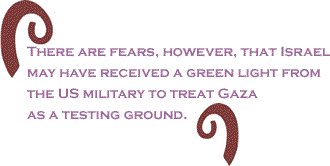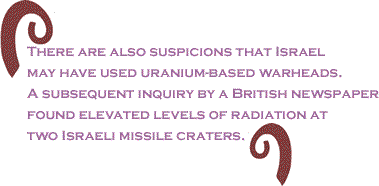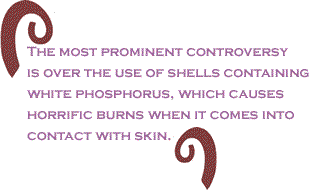|
This
article is republished with permission from The
Electronic Intifada.
Concerns about Israel's use of non-conventional and experimental
weapons in the Gaza Strip are growing, with evasive comments from
spokesmen and reluctance to allow independent journalists inside
the tiny enclave only fueling speculation.
The most prominent controversy is over the use of shells containing
white phosphorus, which causes horrific burns when it comes into
contact with skin. Under international law, phosphorus is allowed
as a smokescreen to protect soldiers but treated as a chemical weapon
when used against civilians.
The Israeli army maintains that it is using only weapons authorized
in international law, though human rights groups have severely criticized
Israel for firing phosphorus shells over densely populated areas
of Gaza.
But there might be other unconventional weapons Israel is using
out of sight of the watching world.
One such munition may be DIME, or dense inert metal explosive, a
weapon recently developed by the United States army to create a
powerful and lethal blast over a small area.
The munition is supposed to still be in the development stage and
is not yet regulated. There are fears, however, that Israel may
have received a green light from the US military to treat Gaza as
a testing ground.

"We have seen Gaza used as a laboratory for testing what I
call weapons from hell," said David Halpin, a retired British
surgeon and trauma specialist who has visited Gaza on several occasions
to investigate unusual injuries suffered by Gazans.
"I fear the thinking in Israel is that it is in its interests
to create as much mutilation as possible to terrorize the civilian
population in the hope they will turn against Hamas."
Gaza's doctors, including one of the few foreigners there, Mads
Gilbert, a Norwegian specialist in emergency medicine working at
al-Shifa hospital in Gaza City, report that many of the injuries
they see are consistent with the use of DIME.
Wounds from the weapon are said to be distinctive. Those exposed
to the blast have severed or melted limbs, or internal ruptures,
especially to soft tissue such as the abdomen, that often lead to
death.
There is said to be no shrapnel apart from a fine "dusting"
of minute metal particles on damaged organs visible when autopsies
are carried out. Survivors of a DIME blast are at increased risk
of developing cancer, according to research carried out in the United
States.
Traditional munitions, by contrast, cause large wounds wherever
shrapnel penetrates the body.
"The power of the explosion dissipates very quickly and the
strength does not travel long, maybe 10 meters, but those humans
who are hit by this explosion, this pressure wave, are cut in pieces,"
Dr Gilbert said in a recent interview.

This is not the first time concerns about Israel's use of DIME have
surfaced in Gaza. Doctors there reported strange injuries they could
not treat, and from which patients died unexpectedly days later,
during a prolonged wave of Israeli air strikes in 2006.
A subsequent Italian investigation found Israel was using a prototype
weapon similar to DIME. Samples from victims in Gaza showed concentrations
of unusual metals in their bodies.
Yitzhak Ben-Israel, the former head of the Israeli military's weapons
development program, appeared familiar with the weapon, telling
Italian TV that the short radius of the explosion helped avoid injuries
to bystanders, allowing "the striking of very small targets."
 Israeli
denials about using weapons banned by international law would not
cover DIME because it is not yet officially licensed. Israeli
denials about using weapons banned by international law would not
cover DIME because it is not yet officially licensed.
It will be difficult to investigate claims that non-conventional
weapons have been used in Gaza until a ceasefire is agreed, but
previous inquiries have shown that Israel resorts to such munitions.
The Israeli human rights group B'Tselem has recorded numerous occasions
when the Israeli army has fired flechette shells, both in Lebanon
and Gaza. The shell releases thousands of tiny metal darts that
cause horrible injuries to anyone out in the open.
A Reuters cameraman, Fadel Shana, filmed the firing of such a shell
from an Israeli tank in Gaza in April, moments before its flechettes
killed him.
Miri Weingarten, a spokeswoman for Physicians for Human Rights,
said they were watching out for use of a new flechette-type weapon
the Israeli army has developed called kalanit (anemone). An anti-personnel
munition, the shell sends out hundreds of small discs.
Israel appears to have used a range of controversial weapons during
its attack on Lebanon in 2006. After initial denials, an Israeli
government minister admitted that the army had fired phosphorus
shells, and the Israeli media widely reported millions of cluster
bombs being dropped over south Lebanon.

There are also suspicions that Israel may have used uranium-based
warheads. A subsequent inquiry by a British newspaper found elevated
levels of radiation at two Israeli missile craters.
Sarit Michaeli, a spokeswoman for B'Tselem, said her organization
had not yet been able to confirm which weapons were being used in
Gaza in the current attacks. She added, however, that Israel's denials
about using non-conventional munitions should not be relied on.

"It is true, as the army spokespeople say, that weapons such
as phosphorus and flechette shells are not expressly prohibited.
But our view is that such weapons, which do not distinguish between
combatants and non-combatants, cannot be used legally in a densely
populated area like Gaza."
Reports this month revealed that the US has been organizing massive
shipments of arms to Israel, though a Pentagon spokesman denied
they were for use in Gaza.
BlackCommentator.com
Guest Commentator Jonathan Cook is a writer and journalist
based in Nazareth, Israel. His latest books are Israel
and the Clash of Civilisations: Iraq, Iran and the Plan to Remake
the Middle East (Pluto Press) and Disappearing
Palestine: Israel's Experiments in Human Despair
(Pluto Press) and Disappearing
Palestine: Israel's Experiments in Human Despair (Zed Books). His website is www.jkcook.net. Click here to contact Mr. Cook.
(Zed Books). His website is www.jkcook.net. Click here to contact Mr. Cook.

|




































